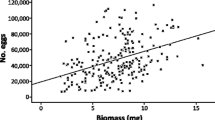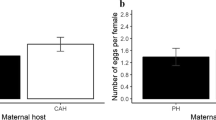Summary
We describe the results of two studies of parasitic infection in the black grouse (Tetrao tetrix). The first deals with our own observations of lekking black grouse in which the parasite levels of two blood parasites, the protozoan Leucocytozoon lovati and microfilaria, probably produced by a nematode worm Splendidofilaria tuvensis, were scored. We also obtained measures of age, survival, number of copulations, body mass and length of the ornamental tail feathers (the lyre) of the lekking males. The second study analysed the data from Lund (1954) which involved eight gut parasites obtained from birds which were killed. In the first study we found higher levels of infection of Leucocytozoon in adults relative to young birds. Parasites had no effect on male survival and there was no correlation in infection between the two types of parasites. Birds infected with microfilaria had shorter tail ornaments. There was no relationship between parasitic infection and mating success. However, the data indicated that such a trend indeed may exist for Leucocytozoon and the most successful males on the leks were less often infected by Leucocytozoon than other males. Results of the second study showed a negative relationship between parasite load (a combined measure of all parasites) and both ornamental tail feather length and body mass. These observations are compatible with, but not conclusive evidence for, the hypothesis of Hamilton and Zuk (1982) on the evolution of secondary sexual characters, where females choose to mate with genetically resistant males which show their resistance by expressing larger and more showy secondary sexual characters. Alternative explanations for the observed patterns are: females avoid infected males for some immediate benefit; and/or parasite loads are indicators of general stress rather than genetical resistance. Under the latter hypothesis females could mate with more vigorous males for reasons unrelated to parasite resistance.
Similar content being viewed by others
References
Alatalo RV, Höglund J, Lundberg A (1991) Lekking in black grouse — a test of male viability. Nature 352:155–156
Alatalo RV, Höglund J, Lundberg A, Sutherland WJ (1992) Evolution of black grouse leks - Female preferences benefits males in larger leks. Behav Ecol (in press)
Bezubik B (1969) Helminth parasites of black grouse (Lyrurus tetrux L.) and capercaillie (Tetrao urogallus L.). Acta Parasitol Pol 8:37–45
Borg K (1953) On Leucocytozoon in Swedish capercaillie, black grouse and hazel grouse. Kungl Vet Högskolans lärarekoll, Stockholm
Borgia G, Collis K (1989) Female choice for parasite-free male satin bower-birds and the evolution of bright male plumage. Behav Ecol Sociobiol 25:445–454
Borgia G, Boyce MS, Clayton DH, Collis K, Gerhardt HC, Gibson RM, Hamilton WD, Hausfater G, Hillgarth N, Johnson K, Jones HI, Klump GM, Ligon JD, Low BS, McMinn H, Pruett Jones MA, Pruett-Jones SG, Thornhill R, Tinsley RC, Zuk M (1990) Symposium: Parasites and sexual selection. Am Zool 30:225–352
Boyce MS (1990) The red queen visits sage grouse leks. Am Zool 263–270
Bradbury JW, Andersson MB (1987) Sexual selection: testing the alternatives. Wiley, Chichester
Clayton DH (1990) Mate choice in experimentally parasitized rock doves: lousy males loose. Am Zool 30:251–262
Gibson RM (1990) Relationships between blood parasites, mating success and phenotypic cues in male sage grouse Centrocercus urophasianus. Am Zool 30:271–276
Hamilton WD, Zuk M (1982) Heritable true fitness and bright birds: a role for parasites. Science 218:384–387
Helminen M (1963) Composition of the Finnish populations of capercaillie, Tetrao urogallus, and black grouse, Lyrurus tetrix, in the autumns of 1952–1961, as revealed by a study of wings. Riistatiet Julk 8:142–149
Hillgarth N (1990) Parasites and female choice in the ring-necked pheasant. Am Zool 30:227–235
Johnson L, Boyce MS (1990) Female choice of males with low parasite loads in sage grouse. In: Loye JE, Zuk M (eds) Ecology, behaviour and evolution of bird-parasite interactions. Oxford University Press, Oxford, pp 377–388
Koivisto I (1965) Behaviour of the black grouse (Lyrurus tetrix L.) during the spring display. Finn Game Res 26:1–60
Kruijt JP, de Vos GJ, Bossema I (1972) The arena system of the black grouse. Proceedings of the International Ornithological Congress XV E.J. Brill, Leiden, pp 399–423
Lund HMK (1954) Nematodes, Cestodes and Coccidia found in 136 black grouse (Lyrurus tetrix) in Norway. Statens Viltunderøkelser, Oslo
Maynard Smith J (1985) Mini-Review: sexual selection, handicaps and true fitness. J Theor Biol 115:1–8
Milinski M, Bakker TCM (1990) Female sticklebacks use male coloration in mate choice and hence avoid parasitized males. Nature 344:330–333
Møller AP (1990) Effects of a haematophagous mite on the barn swallow (Hirundo rustica): a test of the Hamilton and Zuk hypothesis. Evolution 44:771–784
Pruett-Jones SG, Pruett-Jones MA, Jones HI (1990) Parasites and sexual selection in birds of paradise. Am Zool 30:287–298
Raitis T, Helminen M (1969) Keihäsmato-kanalintujemme yleisin suolistoloinen (Ascaridia compar - the most frequent intestinal parasite of gallinaceous birds in Finland). Suom Riista 21:27–39
Read AF (1987) Comparative evidence supports the Hamilton and Zuk hypothesis on parasites and sexual selection. Nature 327:68–70
Read AF, Harvey PH (1989) Reassessment of comparative evidence for the Hamilton and Zuk theory on the evolution of secondary sexual characters. Nature 339:618–620
Read AF, Weary DM (1990) Sexual selection and the evolution of bird song: A test of the Hamilton Zuk hypothesis. Behav Ecol Sociobiol 26:47–56
Ward PI (1988) Sexual dichromatism and and parasitism in British and Irish freshwater fish. Anim Behav 36:1210–1215
Willebrandt T, Marcström V (1989) Marrow, heart and body fat as indicators of Black grouse Tetrao tetrix condition. Ornis Scand 20:49–52
Zbinden N, Hörning B (1985) Zum Endoparasitenbefall von Birkhahn Tetrao tetrix, Alpenschneehuhn Lagopus mutus und Steinhuhn Alectoris graeca im Tessin. Ornithol Beobacht 82:117–120
Zuk M, Johnson K, Thornhill R, Ligon JD (1990a) Parasites and male ornaments in free-ranging and captive red jungle fowl. Behaviour 114:232–248
Zuk M, Thornhill R, Ligon JD, Johnson K (1990b) Parasites and mate choice in red jungle fowl. Am Zool 235–244
Author information
Authors and Affiliations
Rights and permissions
About this article
Cite this article
Höglund, J., Alatalo, R.V. & Lundberg, A. The effects of parasites on male ornaments and female choice in the lek-breeding black grouse (Tetrao tetrix). Behav Ecol Sociobiol 30, 71–76 (1992). https://doi.org/10.1007/BF00173942
Received:
Accepted:
Issue Date:
DOI: https://doi.org/10.1007/BF00173942




